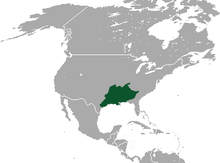Swamp rabbit
| Swamp rabbit[1] Temporal range: Pleistocene–recent[2]
| |
|---|---|

| |
| Scientific classification | |
| Domain: | Eukaryota |
| Kingdom: | Animalia |
| Phylum: | Chordata |
| Class: | Mammalia |
| Order: | Lagomorpha |
| Family: | Leporidae |
| Genus: | Sylvilagus |
| Species: | S. aquaticus
|
| Binomial name | |
| Sylvilagus aquaticus (Bachman, 1837)
| |

| |
| Swamp rabbit range | |
The swamp rabbit (Sylvilagus aquaticus), also called the cane-cutter, is a large cottontail rabbit found in the swamps and wetlands of the southern United States. The species has a strong preference for wet areas, and it will take to the water and swim.[4]
Range and habitat
The swamp rabbit is found in much of the south-central United States and along the
Swamp rabbits mainly live close to
There is concern that swamp rabbits are increasingly becoming exposed to predation, especially during snowy/wintry seasons. Snow cover has shown to increase swamp rabbit mortality by almost two times in the northern extent of their range. This is due mostly to the fact that snow cover constrains hiding ability and availability of food resources.[7]
Physical description
S. aquaticus is the largest of the cottontail species, although its ears are smaller than those of other cottontails.[5] Males are slightly larger than females.[5] The head and back are typically dark or rusty brown or black, while the throat, ventral surface, and tail are white, and there is a cinnamon-colored ring around the eye.[5] Their sides, rump, tail and feet are much more brownish, along with a pinkish-cinnamon eye-ring, as opposed to the whitish eye-ring in eastern cottontails.[4]
S. aquaticus males vary in weight from approximately 4 lb (1.8 kg) to 5.6 lb (2.5 kg), with an average of about 5 lb (2.3 kg); females vary from approx. 3.6 lb (1.6 kg) to 5.9 lb (2.7 kg), averaging about 4.8 lb (2.2 kg). S. aquaticus ranges in length from approx. 17.8 inches (45 cm) to 21.7 in (55 cm), with an average length of about 19.7 in (50 cm).[5]
Predation
Known predators of Sylvilagus aquaticus are
Ontogeny and reproduction
S. aquaticus are

Breeding season varies widely across the range of S. aquaticus, usually occurring anywhere between February and August, but can occur year-round in Texas.
Diet
Swamp rabbits are
Like all lagomorphs, the swamp rabbit creates, expels & eats cecotropes (cecotrophy) to get more nutrition from its food.[5]
Species competition
Rival males will often engage in aggressive encounters that sometimes become violent enough to kill one of the combatants. When fighting, males will stand on their hind legs and use their teeth and claws to inflict wounds on their opponent. They will also jump from the ground and strike with the sharp claws of the hind feet.[4]
See also
References
- OCLC 62265494.
- ^ "Sylvilagus aquaticus (swamp rabbit)". PBDB. Archived from the original on 2021-07-22. Retrieved 2019-08-14.
- . Retrieved 19 November 2021.
- ^ a b c d e f Reed, Don (September 2008). "Wildlife Species Profile Swamp Rabbit (Sylvilagus aquaticus)" (PDF). Louisiana Wildlife News. No. 5. Louisiana State University Agricultural Center. Archived (PDF) from the original on 11 December 2014. Retrieved 25 November 2014.
- ^ a b c d e f g h i j k l m n Sylvilagus aquaticus (swamp rabbit) Archived 2013-05-27 at the Wayback Machine, Animal Diversity Web, University of Michigan Museum of Zoology.
- ^ "NatureServe Explorer 2.0". explorer.natureserve.org. Archived from the original on 24 October 2022. Retrieved 24 October 2022.
- ^ Hillard, Elizabeth M., et al. “Winter Snow Cover Increases Swamp Rabbit (Sylvilagus Aquaticus) Mortality at the Northern Extent of Their Range.” Mammalian Biology, vol. 93, 2018, pp. 93–96., doi:10.1016/j.mambio.2018.09.001.
- ^ "This swamp rabbit can swim: Remarkable Rabbits | CBC.ca". Archived from the original on 2019-04-08. Retrieved 2019-04-08.
- ^ a b Courtney, Emily M. (5 September 2008). "Swamp rabbit (Sylvilagus aquaticus)" (PDF). Mammals in Mississippi. No. 3. Department of Wildlife and Fisheries, Mississippi State University. Archived (PDF) from the original on 23 September 2015. Retrieved 11 December 2014.
External links
 Media related to Sylvilagus aquaticus at Wikimedia Commons
Media related to Sylvilagus aquaticus at Wikimedia Commons

